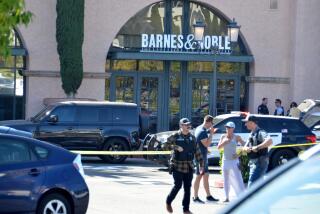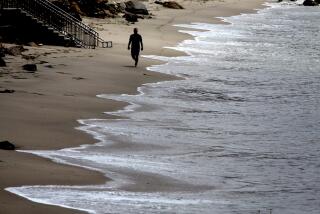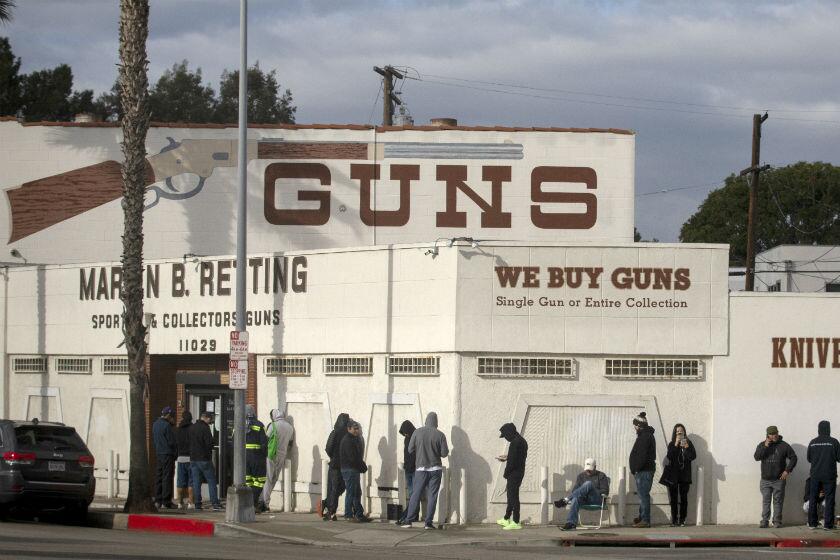A TWIST OF FATE : ‘Most of What I Got . . . Was Pure Embarrassment’
The most arresting truth of fate--or chance, as some wish to call it--is how it intrudes in the lives of everyday people. It affects the weak and strong, the good and bad, the young and old. For some it pops up again and again, often in the strangest ways. Often in the strangest places.
Fate can mean romance. Joan Smith was a barroom singer in St. Paul, Minn., when Ray Kroc walked in. He liked her voice, the way her fingers tickled the ivories. Joan Smith, now Joan Kroc, is one of the world’s wealthiest philanthropists as well as the president of the San Diego Padres.
Fate can mean tragedy--for some it continues to mean that. E. Jack Ridout escaped death by fate three times--he avoided Vietnam, was injured in the world’s worst aviation disaster, and missed a seat on PSA Flight 182, which crashed in San Diego.
Fate can mean taxing survival to the fullest. Auschwitz survivor Helen Waterford came before Mengele three times and three times was spared.
Fate can mean fame, unwanted or otherwise. Photographer Hans Wendt, who almost won the Pulitzer Prize for a picture of the crash of Flight 182, is uncertain of the side effects of fame-at least that imposed by fate.
Fate can mean philosophical, theological (or semantic) confusion. Pastor Paul Pulliam of San Diego’s First Presbyterian Church has puzzled over the meaning of fate, and the role God plays in it.
He isn’t sure of the answers.
Hans Wendt was an ordinary guy doing an ordinary job. He didn’t care to be famous. He was happy taking pictures for the County of San Diego.
So having to take pictures of gasoline nozzles--part of a change in the county’s “vapor recovery” laws--didn’t bother Wendt at all. Not even on a sizzling morning.
Minutes after a press conference about the law change, Wendt heard an explosion. He looked up, to see a 727 jetliner diving from the sky. Despite “turning to jelly,” he had the presence of mind to grab a camera, set the focus to “infinity” and snap twice.
One of Wendt’s photos of PSA Flight 182 was a finalist for the Pulitzer Prize. He lost, beaten out by John H. Blair of United Press International, whose photograph of a hostage being held at gunpoint won the award for spot news. Some photographers think Wendt’s shot was better.
Wendt wishes he had had slower film, a longer lens . . . He doesn’t think it was all that good. And he’s glad he didn’t win the Pulitzer.
“I thought if I had won it, I would have to rent a tuxedo, go to New York, get up on a stage and say thank you. Hey, that’s not Hans,” he said.
Wendt does wonder about fate. He wonders why he was there and not, say, some ace from Life magazine. He turns defensive, however, when asked if his life was changed.
“I’m a professional photographer,” he said. “That’s what I do. It so happens it got more popularity than other things I’ve done. It was a flash-in-the-pan type picture. It didn’t involve any skill. Just acquired instincts, honed over years of doing it automatically. It was just second nature.”
Wendt, 51, is a tall man of slightly disheveled appearance with glasses that slip down the nose, even more so in the heat of a summer day. Before Flight 182, he had fantasies of photographing a flying saucer.
He has heard the Andy Warhol line--”In the future everybody will be famous for 15 minutes”--and said that although he loathes Andy Warhol, he identifies with the concept. He feels a little bit like a second-string guard hitting a last-second shot in high school that no one expected but everyone recalls. It threatens to stay with him the rest of his days.
“Most of what I got from taking that picture was pure embarrassment,” he said.
After he took it, he rushed it to a lab, thinking it might be useful for the Federal Aviation Administration. “Once a bureaucrat, always a bureaucrat,” he said. He suspected a bomb caused the crash. What actually happened never crossed his mind--that the 727 had collided with a single-engine plane.
A television cameraman using the lab at the time Wendt’s picture emerged from fixer called to tell him at least one photograph was stunning. He urged him to sell it right away. Wendt strolled across the hall in the county building to the press room and a cluster of bored-looking newsmen. He offered it to anyone who’d buy it. A reporter from the San Diego Union said his paper wanted it.
Wendt sold the color transparency for $150, a price some considered criminally low. As photojournalists later pointed out, Wendt’s picture is a classic, comparable to the Pulitzer-winning shot of Jack Ruby gunning down Lee Harvey Oswald in the basement of the Dallas police station. The difference between his and other photos: It’s a tragedy in progress.
Newspapers unhappy with the Union’s “scoop” started a controversy, Wendt said, and he particularly mentions The Times. Critics tried to claim that the photo belonged to the county and thus was part of the public domain. Since the photos really weren’t county business, Wendt said he and his bosses agreed he would pay for the roll of film, and for its processing, and the picture would stay forever his. To this day he is mystified and angry why anyone would cause him grief.
For weeks Wendt dealt with the county controversy--”Stupid,” he calls it--and answered phone calls in the middle of the night from men with foreign-sounding voices wanting the picture for their papers. Right away. Finally, on a hot afternoon, sick of the whole mess and wanting to flee, he drove to a shopping center. He ended up at Sears, looking at televisions. Suddenly, an image flickered on dozens of screens simultaneously. The image was Wendt’s picture.
“I felt I couldn’t get away from it,” he said. “I felt . . . trapped. It was all like such a bad dream. A nightmare. I wouldn’t want to do it again.”
More to Read
Start your day right
Sign up for Essential California for news, features and recommendations from the L.A. Times and beyond in your inbox six days a week.
You may occasionally receive promotional content from the Los Angeles Times.






